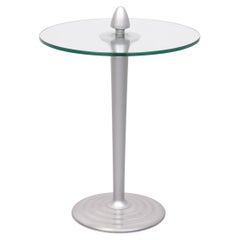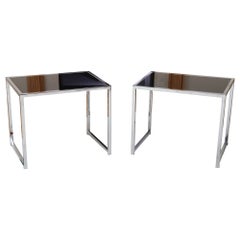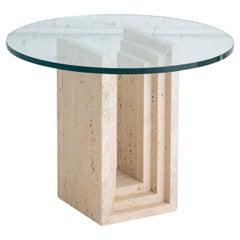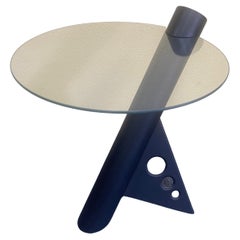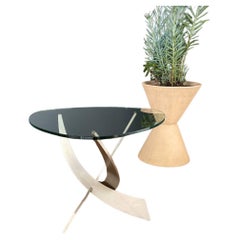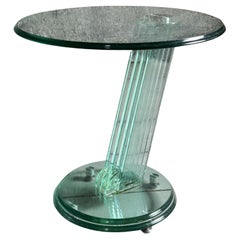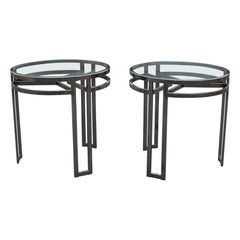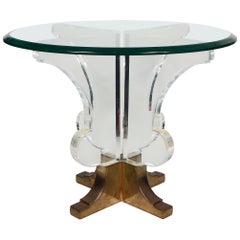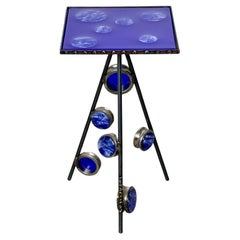Post Modern Glass Side Table
Vintage 1980s Dutch Post-Modern Side Tables
Glass
Mid-20th Century Post-Modern Side Tables
Chrome
Late 20th Century Italian Post-Modern Side Tables
Travertine, Marble
Mid-20th Century Philippine Post-Modern Side Tables
Glass, Wood
Antique 1880s American Post-Modern Side Tables
Steel
Vintage 1980s Post-Modern Side Tables
Glass
Vintage 1980s American Post-Modern Side Tables
Chrome
Vintage 1980s American Post-Modern Side Tables
Brass
Early 2000s American Post-Modern Side Tables
Steel
Vintage 1980s American Post-Modern Side Tables
Copper, Steel
Vintage 1980s Italian Post-Modern Side Tables
Brass, Steel
Vintage 1970s German Hollywood Regency Side Tables
Metal
1990s American Post-Modern Side Tables
Aluminum
Mid-20th Century American Modern Side Tables
Iron, Wrought Iron
Vintage 1970s Italian Post-Modern Side Tables
Travertine
Vintage 1980s American Post-Modern Side Tables
Glass
Mid-20th Century European Post-Modern Side Tables
Cement
Vintage 1980s Italian Post-Modern Side Tables
Steel
Vintage 1970s Taiwanese Post-Modern Side Tables
Brass
Vintage 1980s French Post-Modern Side Tables
Steel
Late 20th Century North American Post-Modern Side Tables
Glass
Late 20th Century European Post-Modern Side Tables
Copper
Vintage 1980s American Post-Modern Side Tables
Brass, Bronze
Vintage 1980s Unknown Post-Modern Side Tables
Glass, Plaster
20th Century Italian Post-Modern Side Tables
Glass
2010s Italian Post-Modern Side Tables
Bronze
Vintage 1970s American Post-Modern Side Tables
Chrome
2010s Italian Post-Modern Side Tables
Glass
Vintage 1980s Italian Post-Modern Side Tables
Glass, Wood
20th Century Post-Modern Side Tables
Glass
Vintage 1980s Italian Post-Modern Side Tables
Glass
Late 20th Century American Post-Modern Side Tables
Chrome
Vintage 1980s Dutch Post-Modern Side Tables
Marble, Chrome
2010s Italian Post-Modern Side Tables
Glass, Burl
Vintage 1970s American Post-Modern Side Tables
Glass, Formica
2010s Italian Post-Modern Side Tables
Glass
2010s Italian Post-Modern Side Tables
Glass
Vintage 1980s Italian Post-Modern Side Tables
Marble, Steel
2010s Italian Post-Modern Side Tables
Smoked Glass
Late 20th Century Unknown Post-Modern Side Tables
Metal
Vintage 1980s French Post-Modern Side Tables
Metal, Aluminum
Vintage 1980s American Post-Modern Side Tables
Steel
2010s Italian Post-Modern Side Tables
Glass
2010s Turkish Post-Modern Side Tables
Travertine
Vintage 1970s French Post-Modern Side Tables
Metal
Vintage 1970s French Post-Modern Side Tables
Metal
Late 20th Century American Post-Modern Side Tables
Metal
Late 20th Century American Post-Modern Side Tables
Steel
Vintage 1980s Mid-Century Modern Side Tables
Marble, Brass
2010s Danish Post-Modern Side Tables
Steel
2010s Danish Post-Modern Side Tables
Steel
2010s Danish Post-Modern Side Tables
Steel
Vintage 1970s American Mid-Century Modern Side Tables
Marble
2010s Turkish Post-Modern Side Tables
Onyx
2010s Turkish Post-Modern Side Tables
Travertine
2010s Turkish Post-Modern Side Tables
Onyx
Late 20th Century Unknown Post-Modern Side Tables
Stone
Vintage 1980s Italian Post-Modern Side Tables
Aluminum
- 1
- ...
Post Modern Glass Side Table For Sale on 1stDibs
How Much is a Post Modern Glass Side Table?
A Close Look at Post-modern Furniture
Postmodern design was a short-lived movement that manifested itself chiefly in Italy and the United States in the early 1980s. The characteristics of vintage postmodern furniture and other postmodern objects and decor for the home included loud-patterned, usually plastic surfaces; strange proportions, vibrant colors and weird angles; and a vague-at-best relationship between form and function.
ORIGINS OF POSTMODERN FURNITURE DESIGN
- Emerges during the 1960s; popularity explodes during the ’80s
- A reaction to prevailing conventions of modernism by mainly American architects
- Architect Robert Venturi critiques modern architecture in his Complexity and Contradiction in Architecture (1966)
- Theorist Charles Jencks, who championed architecture filled with allusions and cultural references, writes The Language of Post-Modern Architecture (1977)
- Italian design collective the Memphis Group, also known as Memphis Milano, meets for the first time (1980)
- Memphis collective debuts more than 50 objects and furnishings at Salone del Milano (1981)
- Interest in style declines, minimalism gains steam
CHARACTERISTICS OF POSTMODERN FURNITURE DESIGN
- Dizzying graphic patterns and an emphasis on loud, off-the-wall colors
- Use of plastic and laminates, glass, metal and marble; lacquered and painted wood
- Unconventional proportions and abundant ornamentation
- Playful nods to Art Deco and Pop art
POSTMODERN FURNITURE DESIGNERS TO KNOW
- Ettore Sottsass
- Robert Venturi
- Alessandro Mendini
- Michele de Lucchi
- Michael Graves
- Nathalie du Pasquier
VINTAGE POSTMODERN FURNITURE ON 1STDIBS
Critics derided postmodern design as a grandstanding bid for attention and nothing of consequence. Decades later, the fact that postmodernism still has the power to provoke thoughts, along with other reactions, proves they were not entirely correct.
Postmodern design began as an architectural critique. Starting in the 1960s, a small cadre of mainly American architects began to argue that modernism, once high-minded and even noble in its goals, had become stale, stagnant and blandly corporate. Later, in Milan, a cohort of creators led by Ettore Sottsass and Alessandro Mendini — a onetime mentor to Sottsass and a key figure in the Italian Radical movement — brought the discussion to bear on design.
Sottsass, an industrial designer, philosopher and provocateur, gathered a core group of young designers into a collective in 1980 they called Memphis. Members of the Memphis Group, which would come to include Martine Bedin, Michael Graves, Marco Zanini, Shiro Kuramata, Michele de Lucchi and Matteo Thun, saw design as a means of communication, and they wanted it to shout. That it did: The first Memphis collection appeared in 1981 in Milan and broke all the modernist taboos, embracing irony, kitsch, wild ornamentation and bad taste.
Memphis works remain icons of postmodernism: the Sottsass Casablanca bookcase, with its leopard-print plastic veneer; de Lucchi’s First chair, which has been described as having the look of an electronics component; Martine Bedin’s Super lamp: a pull-toy puppy on a power-cord leash. Even though it preceded the Memphis Group’s formal launch, Sottsass’s iconic Ultrafragola mirror — in its conspicuously curved plastic shell with radical pops of pink neon — proves striking in any space and embodies many of the collective’s postmodern ideals.
After the initial Memphis show caused an uproar, the postmodern movement within furniture and interior design quickly took off in America. (Memphis fell out of fashion when the Reagan era gave way to cool 1990’s minimalism.) The architect Robert Venturi had by then already begun a series of plywood chairs for Knoll Inc., with beefy, exaggerated silhouettes of traditional styles such as Queen Anne and Chippendale. In 1982, the new firm Swid Powell enlisted a group of top American architects, including Frank Gehry, Richard Meier, Stanley Tigerman and Venturi to create postmodern tableware in silver, ceramic and glass.
On 1stDibs, the vintage postmodern furniture collection includes chairs, coffee tables, sofas, decorative objects, table lamps and more.
Finding the Right Tables for You
The right vintage, new or antique tables can help make any space in your home stand out.
Over the years, the variety of tables available to us, as well as our specific needs for said tables, has broadened. Today, with all manner of these must-have furnishings differing in shape, material and style, any dining room table can shine just as brightly as the guests who gather around it.
Remember, when shopping for a dining table, it must fit your dining area, and you need to account for space around the table too — think outside the box, as an oval dining table may work for tighter spaces. Alternatively, if you’ve got the room, a Regency-style dining table can elevate any formal occasion at mealtime.
Innovative furniture makers and designers have also redefined what a table can be. Whether it’s an unconventional Ping-Pong table, a brass side table to display your treasured collectibles or a Louis Vuitton steamer trunk to add an air of nostalgia to your loft, your table can say a lot about you.
The visionary work of French designer Xavier Lavergne, for example, includes tables that draw on the forms of celestial bodies as often as they do aquatic creatures or fossils. Elsewhere, Italian architect Gae Aulenti, who looked to Roman architecture in crafting her stately Jumbo coffee table, created clever glass-topped mobile coffee tables that move on bicycle tires or sculpted wood wheels for Fontana Arte.
Coffee and cocktail tables can serve as a room’s centerpiece with attention-grabbing details and colors. Glass varieties will keep your hardwood flooring and dazzling area rugs on display, while a marble or stone coffee table in a modern interior can showcase your prized art books and decorative objects. A unique vintage desk or writing table can bring sophistication and even a bit of spice to your work life.
No matter your desired form or function, a quality table for your living space is a sound investment. On 1stDibs, browse a collection of vintage, new and antique bedside tables, mid-century end tables and more .
